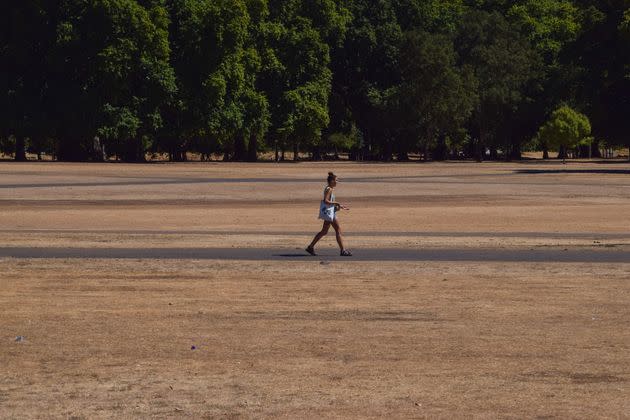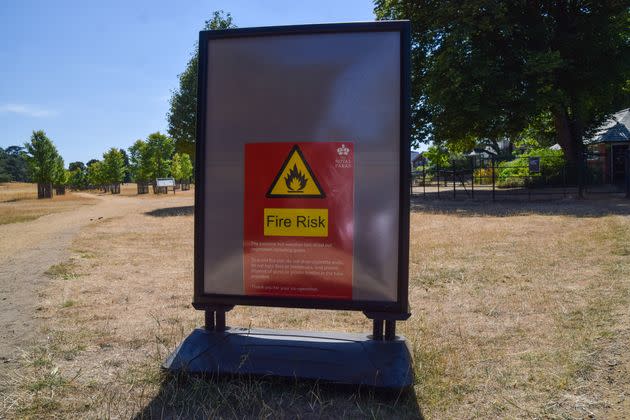Where Is The UK's Latest Heatwave Coming From?

A woman walks in a parched Hyde Park on a scorching day as heatwaves and drought caused by climate change continue in the UK. (Photo: SOPA Images via Getty Images)
For most Brits, it’s now come to the point where we can’t actually remember the last time it rained – and that, dear reader, is a very unnatural position to be in for a country that loves to moan about the weather.
We’re in the grips of yet another heatwave, with temperatures in most places reaching the high 20s, and central and southern areas hitting the low 30s.
While this latest bout of weather is not as extreme as July’s heatwave – when fires broke out and the UK reached a record temperature of 40.3ºC in Lincolnshire – it’s still giving meteorologists cause for concern, with the UK’s leading health body issuing yet another health warning.
There has also been a noticeable lack of rain throughout July and August. In fact, England recorded its driest July since 1935 this year, resulting in multiple water companies issuing hosepipe bans – and there’s little in the way of meaningful rain in the forecast.
So what’s behind this recent bout of dry and very toasty weather? Stephen Dixon, a spokesperson for the Met Office, tells HuffPost UK this latest heatwave is occurring due to a “stubborn area of high pressure sat over the UK”.
“This has happened partly due to a shift in the jet stream to the far north, which allows high pressure to build from the south,” he explains.
While July’s heatwave was from a surge of warm continental air (it was down to a pressure system called the Azores High, which usually sits off Spain but had expanded and pushed further north), this heatwave is “more home grown in nature”, says Dixon.

A fire risk sign is seen in a dry Richmond Park as heatwaves and drought conditions caused by climate change continue across the UK. (Photo: SOPA Images via Getty Images)
Temperatures have been allowed to build day-on-day, and the high pressure is essentially repelling any weather fronts which usually bring with them rain and more unsettled conditions.
Clouds are scarce, wind even more so, meaning the sun can reach the ground without any influence, allowing temperatures to rise through the day.
The average August maximum temperature for the UK is normally around 19.3ºC, so this latest bout of weather “is significantly above average,” adds Dixon.
Ultimately, experts believe the extreme weather changes we are seeing – the more intense, frequent and longer-lasting heatwaves – are enabled by climate change.
In Europe and other parts of the world we are seeing more and more record-breaking heatwaves causing extreme temperatures that have become hotter faster than in most climate models, according to Friederike Otto, a senior climate lecturer at the Grantham Institute for Climate Change at Imperial College London.
“It’s a worrying finding,” said Otto, “that suggests that if carbon emissions are not rapidly cut, the consequences of climate change on extreme heat in Europe, which already is extremely deadly, could be even worse than we previously thought.”
This article originally appeared on HuffPost UK and has been updated.

 Yahoo Movies
Yahoo Movies 